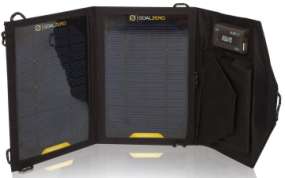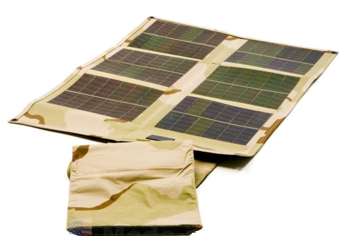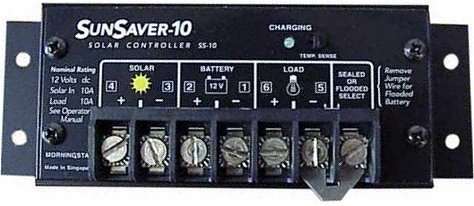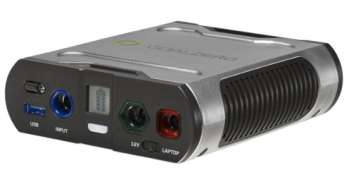Solar Power on Field Day 2013
Photovoltaic cells: turning sunlight into electricity
On a bright sunny day about one thousand watts of energy falls to the Earth on every square meter in the form of sunlight. This energy heats the Earth, drives the winds, gives plants the energy they need to grow, and can give you a wicked sunburn. (With a thousand watts constantly irradiating your roughly one
square meter of hide it is no wonder you can get burned in just a few minutes if conditions are right.)
Solar cells, also called photovoltaic cells, convert the energy of light directly into electricity. What a wonder it would be if we could convert 100% of the energy we receive into electricity. That is, imagine a home that needs roughly 10 megawatts per year to run. That comes out to be about 1200 watts every hour of every day (on average). Sometimes that home would draw more. For example, the there are lights on at night when none are needed during the day, the dishwasher runs occasionally, and hairdryers run in the morning. There are also plenty of times when that household would use far less than 1200 watts. Very little is used when everyone is sleeping, for example. If the sun would shine 24 hours a day, and we could convert 100% of that solar energy to electricity, we could provide 100% of the power for that household with a panel a little more than a meter square and a suitable battery system. That would be truly amazing!
Of course the Sun doesn’t shine at night and solar cells are far less than 100% efficient. The best solar cell technology available commercially is based on monocrystalline silicon and it can be about 17% efficient. Other technologies such as thin film and polycrystalline silicon are even lower (around 10% efficient). These sound like small numbers but don’t be discouraged. Significant amounts of electricity can be produced by solar panels if one is willing to cover a big area.
square meter of hide it is no wonder you can get burned in just a few minutes if conditions are right.)
Solar cells, also called photovoltaic cells, convert the energy of light directly into electricity. What a wonder it would be if we could convert 100% of the energy we receive into electricity. That is, imagine a home that needs roughly 10 megawatts per year to run. That comes out to be about 1200 watts every hour of every day (on average). Sometimes that home would draw more. For example, the there are lights on at night when none are needed during the day, the dishwasher runs occasionally, and hairdryers run in the morning. There are also plenty of times when that household would use far less than 1200 watts. Very little is used when everyone is sleeping, for example. If the sun would shine 24 hours a day, and we could convert 100% of that solar energy to electricity, we could provide 100% of the power for that household with a panel a little more than a meter square and a suitable battery system. That would be truly amazing!
Of course the Sun doesn’t shine at night and solar cells are far less than 100% efficient. The best solar cell technology available commercially is based on monocrystalline silicon and it can be about 17% efficient. Other technologies such as thin film and polycrystalline silicon are even lower (around 10% efficient). These sound like small numbers but don’t be discouraged. Significant amounts of electricity can be produced by solar panels if one is willing to cover a big area.
Solar Panel Efficiency
If 100% of the energy falling on to the panel could be converted into electricity then the panel would be 100% efficient. Given a particular panel can we estimate its efficiency? The answer is yes, and it can be done with little more than a ruler and a calculator. Consider the Goal Zero Nomad 7 solar panel unit. This product is organized as a folding unit with two solar cell
areas rated at 7 watts. To determine the solar panel’s efficiency measure the active solar cell area (in square meters), and multiply that by 1000 to determine the
number of watts that would be generated by a 100% efficient panel. In this case, there are two areas measuring 180mm x 125mm. That is a total area of 0.045 square meters. Multiplying by 1000 we get 45. That is, if this panel were 100% efficient it would produce 45 watts.
areas rated at 7 watts. To determine the solar panel’s efficiency measure the active solar cell area (in square meters), and multiply that by 1000 to determine the
number of watts that would be generated by a 100% efficient panel. In this case, there are two areas measuring 180mm x 125mm. That is a total area of 0.045 square meters. Multiplying by 1000 we get 45. That is, if this panel were 100% efficient it would produce 45 watts.
Since the panel only produces 7 watts, we can determine the efficiency by dividing 7 by 45 (the amount it delivers divided by that theoretical maximum) and we get a value between 15 and 16% efficient. Since the product is made from monocrystalline silicon cells we expected a number close to this.
Goal Zero also makes a solar panel system with eight solar cell sections instead of two. The Nomad 27 panel is rated at 27 watts. The surface area receiving the light is four times greater than that of the Nomad 7 (0.18 meters). Multiplying 0.18 by 1000 we get 180 watts for a 100% efficient panel. Since the panel only produces 27 watts we divide 27 by 180 and get 15% efficiency. (This is what we expect; it is the same technology so it should have the same efficiency.)
What about a panel that uses different technology? Global Solar model P3-15 is a solar panel rated at 15 watts. It uses a flexible, non-silicon based technology called CIGS (Copper Indium Gallium di-Selinide) that is tough enough to be used by the military. This panel has 12 cell areas that are 90mm x 210mm for a total area of 0.23 square meters. Multiplying 0.23 by 1000 we get 230 watts that would be produced by a 100% efficient panel. This panel only produces 15 watts. So, 15/230 is about 6%. This panel is less than half as efficient as the rigid monocrystalline silicon-based panels. Then again, the manufacturer claims the flexible panel will take a bullet and keep working! That’s an interesting trade-off.
Goal Zero also makes a solar panel system with eight solar cell sections instead of two. The Nomad 27 panel is rated at 27 watts. The surface area receiving the light is four times greater than that of the Nomad 7 (0.18 meters). Multiplying 0.18 by 1000 we get 180 watts for a 100% efficient panel. Since the panel only produces 27 watts we divide 27 by 180 and get 15% efficiency. (This is what we expect; it is the same technology so it should have the same efficiency.)
What about a panel that uses different technology? Global Solar model P3-15 is a solar panel rated at 15 watts. It uses a flexible, non-silicon based technology called CIGS (Copper Indium Gallium di-Selinide) that is tough enough to be used by the military. This panel has 12 cell areas that are 90mm x 210mm for a total area of 0.23 square meters. Multiplying 0.23 by 1000 we get 230 watts that would be produced by a 100% efficient panel. This panel only produces 15 watts. So, 15/230 is about 6%. This panel is less than half as efficient as the rigid monocrystalline silicon-based panels. Then again, the manufacturer claims the flexible panel will take a bullet and keep working! That’s an interesting trade-off.
All-in-one Designs
The modular approach makes it easy to substitute solar panels, batteries, and charge controllers. There are advantages, however, to all-in-one designs that make connections more simple and the whole system smaller and more manageable. Goal Zero makes a variety of units that combine a high-density battery, solar charge controller, and various voltage regulators into a small, easy to carry package. The Sherpa 50 is such a unit.
The Goal Zero Sherpa 50 contains a 50 watt-hour battery, a solar charge controller, USB charging port, super-bright LED flashlight, a 12-volt regulated power port, and a 19-volt regulated power port for PC laptops. The device weighs just over a pound and is 4.5 x 5.2 x 1.5 inches in size.
The connections in the field are simple: connect the solar panel to the input (blue port), connect the radio to the 12-volt port via one of the various adapters that are available), and work away. The internal battery can be charged from house current with an AC charger, from a 12-volt car adapter, or from solar panels. It is small enough to stick in your bag while traveling to help keep your phone, music player, and electronic book reader charged. It is powerful enough to keep a 3-watt light such as the matching Goal Zero Light-a-Life LED light working for about 15 hours.
The Goal Zero Sherpa 50 contains a 50 watt-hour battery, a solar charge controller, USB charging port, super-bright LED flashlight, a 12-volt regulated power port, and a 19-volt regulated power port for PC laptops. The device weighs just over a pound and is 4.5 x 5.2 x 1.5 inches in size.
The connections in the field are simple: connect the solar panel to the input (blue port), connect the radio to the 12-volt port via one of the various adapters that are available), and work away. The internal battery can be charged from house current with an AC charger, from a 12-volt car adapter, or from solar panels. It is small enough to stick in your bag while traveling to help keep your phone, music player, and electronic book reader charged. It is powerful enough to keep a 3-watt light such as the matching Goal Zero Light-a-Life LED light working for about 15 hours.
Experience at the SSB Station
The PART Field Day effort included three HF stations: one for CW, Data, and SSB. The SSB station was powered by a Goal Zero Sherpa 120 unit, the big brother to the Sherpa 50. (The Sherpa 120 unit has a 120 watt-hour battery instead of the 50 watt-hour in the smaller unit.)
Two 27-watt solar panels were placed flat on the ground just outside the window to continuously charge the battery. Trees threw some shade over the panels and occasional cloud cover reduced the total amount of light the panels received on Saturday but the battery showed a 100% charge until well after sundown. In other words, though the radio was in constant use from 2:00 PM on, the battery did not waver from 100% charged while the Sun was shining. We were operating on the power of the Sun alone (using the battery to buffer that power). The Elecraft KX3 drew about 1 watt on receive and about 25 watts on transmit. Even with the reduced light falling on the two panels there was enough power to run the radio and keep the battery topped off.
After sundown the system was running completely on the battery and the energy stored from the Sun the previous day. The battery meter showed 60% remaining when the Sun peeked over the horizon Sunday morning. Sliding the panels out of the shadows and into the sunlight started the recharging process. The radio continued to work chewing up QSOs until nearly 2:00PM. The battery showed 80% full when we stopped. So, not only did the panels run the radio Sunday after daybreak, it also was able to put back approximately 25 watt-hours of energy into the Sherpa 120 battery.
Two 27-watt solar panels were placed flat on the ground just outside the window to continuously charge the battery. Trees threw some shade over the panels and occasional cloud cover reduced the total amount of light the panels received on Saturday but the battery showed a 100% charge until well after sundown. In other words, though the radio was in constant use from 2:00 PM on, the battery did not waver from 100% charged while the Sun was shining. We were operating on the power of the Sun alone (using the battery to buffer that power). The Elecraft KX3 drew about 1 watt on receive and about 25 watts on transmit. Even with the reduced light falling on the two panels there was enough power to run the radio and keep the battery topped off.
After sundown the system was running completely on the battery and the energy stored from the Sun the previous day. The battery meter showed 60% remaining when the Sun peeked over the horizon Sunday morning. Sliding the panels out of the shadows and into the sunlight started the recharging process. The radio continued to work chewing up QSOs until nearly 2:00PM. The battery showed 80% full when we stopped. So, not only did the panels run the radio Sunday after daybreak, it also was able to put back approximately 25 watt-hours of energy into the Sherpa 120 battery.

Figure 1 The Goal Zero Nomad 7 solar panel system

Figure 2 Global Solar model P3-15 solar panel

Figure 3 Morningstar SunSaver-10 solar charge controller

Figure 4 Goal Zero Sherpa 50 power unit
Everyday Uses
My main reason for having the Sherpa 120 and Sherpa 50 units is to provide emergency power and lighting. They are also tasked with keeping my phone, tablet, and electronic readers charged. Some of these devices can be quite thirsty as they may have very large internal batteries. Consider the Apple iPad with Retina display and its 42.5 watt-hour battery. That is nearly the same capacity as the Sherpa 50!
Phones are less power-hungry. The Phone 5 Battery is a 5.45 watt-hour battery. Something like a Sherpa 50 can recharge a phone several times before needed to be replenished itself. Then again, we have two phones, two iPads, several electronic book readers, and a few other devices that may need to stay charged during an extended power outage. Multiple solar-charged batteries provide for all this and lights as well.
When the Sun shines power is delivered to your home—even when the power company fails. Are you ready to catch some rays?
Phones are less power-hungry. The Phone 5 Battery is a 5.45 watt-hour battery. Something like a Sherpa 50 can recharge a phone several times before needed to be replenished itself. Then again, we have two phones, two iPads, several electronic book readers, and a few other devices that may need to stay charged during an extended power outage. Multiple solar-charged batteries provide for all this and lights as well.
When the Sun shines power is delivered to your home—even when the power company fails. Are you ready to catch some rays?
Web Resources
Copyright © 2013-2020 B. Scott Andersen. All Rights Reserved.


